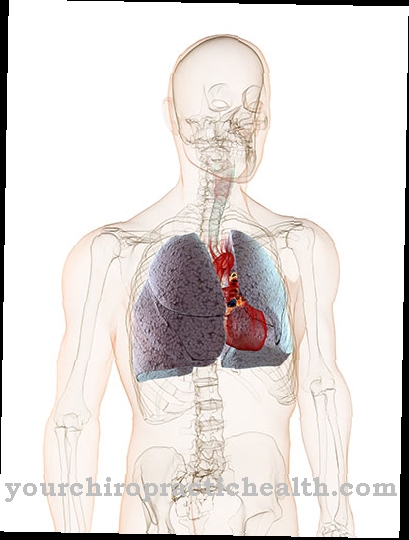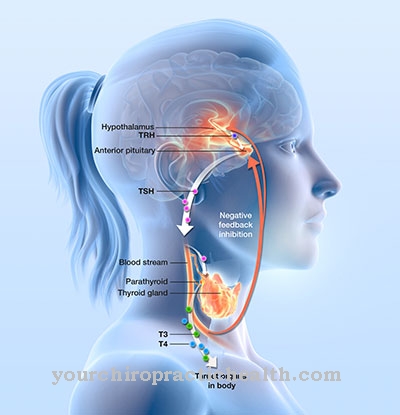Caries or. Tooth decay is one of the most common infectious diseases in Europe, with the typical causes of toothache and dark discoloration of the teeth. Tooth decay is caused by bacteria that colonize around the teeth and attack the tooth enamel. Particularly unbrushed teeth with sugary food residues between the corners are particularly popular with caries bacteria.
What is tooth decay?

The dental disease Caries is one of the most common diseases in industrialized countries. Almost everyone is affected by this disease at least once in a lifetime. The upper and back teeth are much more likely to be affected by tooth decay; Also, at a certain age, the onset of the disease increases. Children between the ages of four and eleven and men and women between the ages of 55 and 65 are particularly susceptible to this dental disease.
Basically, however, tooth decay is a disease that can occur at any age and affect any tooth. Adequate oral hygiene and dental care can already help prevent tooth decay. The right brushing technique is just as important here as regularly changing the toothbrush, namely at least every three months. After brushing your teeth, do not fail to rinse your mouth with a mouthwash for at least 30 seconds. Furthermore, regular visits to the dentist and a healthy diet with little sugar are of course important so that tooth decay does not occur in the first place.
causes
Caries is triggered in most cases by bacteria that settle on the teeth and damage the tooth enamel here. However, many more factors are responsible for the development of tooth decay. Not only does the tooth structure of an individual play a decisive role, diet can also be responsible for the onset of the disease. Sugary foods in particular promote the development of tooth decay; This in connection with bacteria on the teeth offer the best conditions for caries to settle.
In addition, the amount and composition of human saliva can play a role in the development of tooth decay. An increased amount of saliva leads to a better removal of the food and thus gives harmful bacteria less chance of spreading.
Symptoms, ailments & signs
At the beginning of the caries attack, the infection often runs without noticeable symptoms. The so-called initial caries can develop without any visible signs. In advanced stages, tooth decay leads to visible holes in the teeth, as the substance is broken down by the metabolic products of the bacteria. It is also possible that a tooth is hollowed out.
The holes are usually dark in color. A tooth can be completely lost if there is a lot of caries. If the dentist does not remove the tooth residue in such a case, a dark stump remains. Visible holes and dark discolorations do not always form on the chewing surfaces of the teeth. Tooth decay can also develop on the inside or between the teeth.
In addition to the visible symptoms, tooth decay can lead to a number of other complaints. This includes toothache, which can vary in severity. Permanent toothache is also possible. Bad breath can persist even after brushing your teeth or reappear shortly after brushing your teeth.
Teeth that are affected by tooth decay can be extremely sensitive. For example, they react more strongly to heat, cold or the consumption of certain foods. The sensations range from an increased perception of the stimulus or a pulling to severe pain. Bad breath may also occur as a result of tooth decay.
Course of disease
Will the disease Caries If not properly treated, in the worst case not only the tooth enamel is attacked, but possibly also the tooth nerve.
In the worst case, this can lead to failure of the affected tooth. In the early stages, tooth decay is usually noticeable through light or brownish spots on the teeth, the so-called caries spots. Later these can become dark and even black.
At this stage of the disease, the tooth decay is already painful; At least now, a dentist should be visited as soon as possible. The loss or loosening of existing fillings can be a further indication of an existing tooth decay.
A side effect of tooth decay, which is observed by many patients, is the sensitivity to pain to both hot, cold and sweet foods.
Complications
Tooth decay occurs when oral hygiene is neglected, causing bacteria to eat their way into the tooth. The tooth is broken down by the bacteria, creating a hole in the tooth. Of course, this picture is fraught with various complications that can only be eliminated with medical treatment. In many cases, tooth decay causes severe and long-lasting toothache that can only be eliminated by visiting the dentist.
If you leave this clinical picture without any treatment, you are putting yourself at great risk. The bacteria will then continue to decompose the tooth, so the pain will also increase significantly. In this context, it is not uncommon for an inflammation to develop that forms directly under the tooth. An abscess can even develop.
An abscess is a cavity that is filled with pus. If the bacteria in it get into the human bloodstream, there is even a risk of blood poisoning. In the worst case scenario, there is an acute danger to life if this complication remains without any treatment.
Thus, the following applies: Caries can also cause various complications if going to the doctor is put off the back burner. Only through medical treatment can complications be avoided or identified early and explicitly treated.
You can find your medication here
➔ Toothache medicationWhen should you go to the doctor?
People who suffer from any form of toothache should see a dentist as soon as possible. Since spontaneous healing only occurs in exceptional cases, a visit to the doctor is advisable as soon as the first pain is felt. If the person concerned suffers from hypersensitivity in the mouth when eating warm or cold food, there are irregularities that should be clarified. If a pulling or painful sensation is perceived when consuming sweet or sour foods or liquids, a doctor's visit is necessary.
If the discomfort spreads to surrounding teeth or the jaw or if it intensifies, dental treatment is required. Otherwise there is a risk of tooth loss or permanent dentures. If there is an accumulation of food residues in the interdental spaces, holes are noticed in the teeth or if an existing denture becomes loose, a doctor should be consulted. If people in the immediate vicinity notice an unusual bad breath in the person concerned or if unusual discoloration of the teeth occurs, a doctor should be consulted.
Chalk-like stains on teeth are particularly worrying. If the person concerned feels a light tapping on the tooth as painful or very uncomfortable, this is an indication of a caries disease. If an abscess forms, a doctor's visit is also necessary.
Doctors & therapists in your area
Treatment & Therapy
Treatment of Caries depends on how far the disease has progressed. In the case of deeper tooth defects, the affected area is treated with the drill and the caries removed. Local anesthesia of the tooth nerve is usually performed here.
One possibility that has recently become more and more popular is so-called laser technology; with this the patient does not feel any pain. The holes created by drilling are closed with special dental fillings, usually with amalgam.
The dentist usually recognizes tooth decay by looking in the mouth. In the early stages, x-rays also provide information. If the tooth decay is more advanced and the dental nerve is affected, the treating doctor will try to fill in the root.
Outlook & forecast
With today's medical possibilities, there is a good chance of a cure for a caries disease. As soon as tooth decay is diagnosed, treatment takes place immediately afterwards. The dentist removes the affected areas in the mouth and tries to cure the disease through professional teeth cleaning and protection against an immediate new infestation of bacteria. The possibilities of protection, however, are not permanent. Immediately the next time you eat food, new bacteria can get into your mouth that can only be removed by cleaning your teeth properly.
Without dental care, the sufferer cannot achieve healing. If tooth decay has already broken out, the possibilities of self-help are insufficient to achieve recovery. The bacteria multiply in the mouth and cause further damage to the teeth. Immediately after the dental decay has been removed, the patient is responsible for optimizing his teeth cleaning immediately. This is the only way to prevent renewed infestation.
The causes of the disease are discussed in the treatment and should be taken seriously by the patient. A change in behavior is imperative in order to achieve permanent freedom from symptoms. Otherwise, new bacteria will build up in the mouth, which in turn will attack the teeth and cause damage. In the worst case, a tooth loss occurs.
Aftercare
Caries follow-up care is also the basis for successful prevention. It is about protecting the teeth from renewed carious destruction. A sugar-free diet is the basis, which is flanked by cleaning with the right technique and at regular intervals.
Professional teeth cleaning once or twice a year is particularly important in this context. It also removes hard plaque called tartar and soft deposits. Places where the toothbrush does not clean thoroughly, such as the spaces between the teeth or the gum line, are recorded. The PZR is prevention and aftercare at the same time for tooth decay and periodontitis.
Brushing your teeth is very important after meals. It is important to use a brush that is not too hard and thus attacks the tooth enamel. Dental floss, interdental brushes and the use of an oral irrigator after thorough cleaning are ideal to capture the interdental spaces as well as possible. The toothbrush should be changed regularly so that the brushing remains effective.
After cleaning, it is best to rinse it with hot water and then to dry it so that no bacteria that can cause tooth decay can multiply on it. Every person in the household naturally needs their own toothbrush in this context. Children are to be introduced to the cleaning technique in an age-appropriate manner. Parents should carefully control this for their children's dental health.
You can do that yourself
If you suspect tooth decay, you should first make an appointment with the dentist. Acute pain can be relieved by cooling until the examination. If there is actually a disease of the tooth enamel, there is usually only medical treatment for the tooth decay.
In addition, attention should be paid to increased oral hygiene. In addition to the usual recommendations - brush your teeth carefully at least twice a day for three minutes - comprehensive interdental care is recommended. Regular teeth cleaning by the dentist is even better. A sealing of the teeth is also a good option for children.
To prevent the caries from spreading, your diet should also be changed: fruit and vegetables instead of sweets, and mineral water instead of lemonade. Smokers are advised to quit smoking, while coffee drinkers should switch to unsweetened tea. In addition, various home remedies help against tooth decay. Ground nutmeg, for example, which is applied to the hole in the tooth with a little clove oil and kills the bacteria, has proven itself.Salt water and garlic have a similar effect. Clove oil and applications with aniseed or chamomile help against the pain.


.jpg)



.jpg)






.jpg)

.jpg)
.jpg)











.jpg)